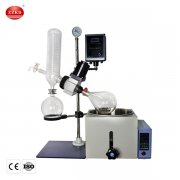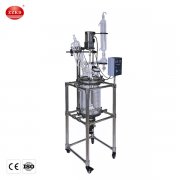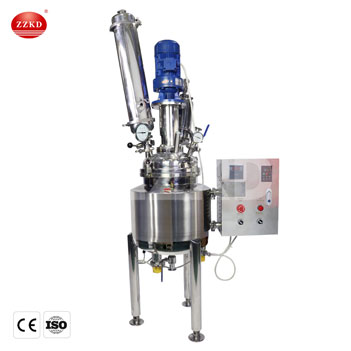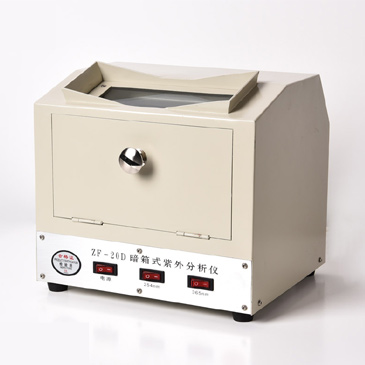Turning a liquid into a free-flowing powder in a matter of seconds may sound like science fiction, yet it happens every day in food, pharma and chemical plants around the world. This article breaks down the real-world speed of spray drying and why a modern spray dryer is often the quickest, cleanest and most economical route to powder.
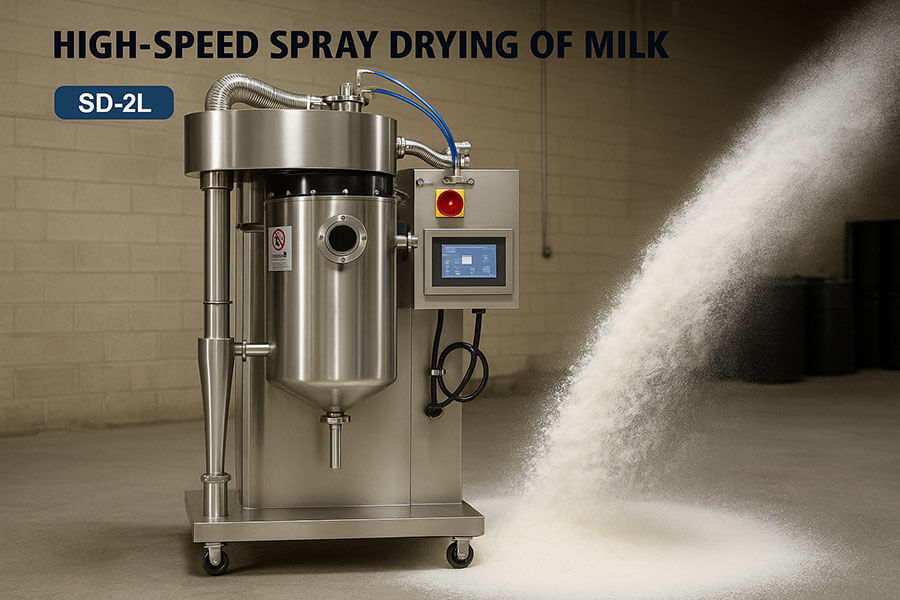
1. From Droplet to Powder in Seconds
In a spray dryer, liquid feed is atomised into micron-scale droplets, exposed to a hot drying medium and collected as a solid powder, all within the briefest of moments. Laboratory measurements show that individual droplets of milk, coffee or probiotics dry in 200–2 000 milliseconds depending on formulation and inlet temperature. Even the entire travel path—nozzle to cyclone—rarely exceeds 5–8 seconds.
2. What Governs the Drying Speed?
Four key variables dictate how fast the process runs:
|
Variable |
Typical Industrial Range |
Effect on Speed |
|
Inlet Air Temperature |
150–220 ℃ (food); up to 300 ℃ (ceramics) |
Higher temperature ⇒ faster moisture removal |
|
Droplet Size |
10–150 µm |
Smaller droplets dry quicker due to larger surface area |
|
Airflow Rate |
0.5–3 m3/s (lab) to >20 m3/s (plant) |
More air means more heat transfer per second |
|
Solid Content of Feed |
5–65 % |
Higher solids may need slightly longer residence time |
← Swipe Left and Right to View the Table→
3. Bench-scale vs. Industrial Scale
Counter-intuitively, the per-droplet drying time remains roughly the same whether the unit handles 500 mL/h in a lab or 5 000 L/h in a dairy. Scale-up mainly increases the number of drying zones and the air volume, allowing millions of droplets to be processed simultaneously without slowing the kinetics.
Question: Does increasing batch size always slow down spray drying?
Answer: Surprisingly, no. Through parallel processing of droplets, a larger dryer keeps the individual residence time constant, so overall throughput rises while cycle time per kilogram remains similar.
4. Comparing With Other Drying Technologies
Conventional tray or tunnel dryers remove moisture by slow diffusion and can take hours. Freeze drying, though gentle, typically lasts 20–36 hours for the same mass. In contrast, spray dryers can achieve water evaporation rates of 1–25 kg H2O per square meter of chamber per hour, orders of magnitude faster. For a visual comparison, see our in-depth article Is a Spray Dryer Better Than a Dehydrator?
5. Why Speed Matters
Shorter residence time translates to:
-
Lower thermal degradation of nutrients, flavours and active compounds
-
Reduced wall build-up and easier cleaning
-
Smaller factory footprint relative to output
-
Improved energy efficiency (kWh per kg water removed)
Did you know? According to a 2023 report by the European Spray Drying Association (ESDA), modern multi-stage spray dryers cut energy consumption by up to 22 % compared with single-stage models built a decade ago.
6. Real-World Case Study — Milk Powder
A 3-pass industrial plant in New Zealand processes raw milk at 40 % solids. Inlet air temperature: 210 ℃; outlet: 85 ℃; evaporation rate: 14 t H2O/h. Total flight time of droplets: 6.2 seconds. The finished powder meets all ISO water-activity limits with a throughput of 7 t powder per hour.
Question: Is such speed achievable with heat-sensitive products like probiotics?
Answer: Yes. By lowering the inlet temperature and using a two-fluid nozzle, probiotic cultures have been dried in under 10 seconds with >95 % viability retained (data from Journal of Functional Foods, 2022).
7. How to Estimate Drying Time For Your Product
While pilot trials remain the gold standard, a first-pass estimate is possible using the simple energy balance shown below. Feel free to download our free calculator inside Guide to Milk Powder Spray Dryers .
Residence time (s) ≈ (ρ · d²) / (6 · k · ΔT)
Where:
ρ = droplet density (kg/m³)
d = droplet diameter (m)
k = heat-transfer coefficient (W/m²·K)
ΔT = temperature difference (K)
8. Frequently Overlooked Speed Boosters
1. Nozzle maintenance – a worn tip increases droplet size, doubling drying time.
2. Feed pre-concentration – using an evaporator to reach higher solids saves latent heat.
3. Cyclone optimisation – improper vortex finders can trap fines and create recirculation.
4. Humidity control – dry ambient air means higher ΔT, so faster drying.
Question: Could AI soon automate these optimisation tweaks?
Answer: Possibly. As reported by MIT Media Lab, “AI-driven process control is predicted to replace manual tuning in 30 % of drying operations by 2030.”
9. Choosing the Right Spray Dryer
Whether scaling a pharmaceutical formulation or producing gourmet coffee, speed alone should not dictate equipment choice. Consider particle morphology, bulk density, solvent recovery and regulations such as ATEX or cGMP. For a side-by-side comparison of benchtop models, see our buyer’s guide on laboratory spray dryers .
Still unsure whether spray drying fits your application? You may also find these resources helpful:
10. Key Takeaways
-
Spray drying is an ultra-fast process: droplets dry in milliseconds, batches in mere seconds.
-
The speed is governed by temperature, droplet size, airflow and feed solids.
-
Compared with freeze or tray drying, spray drying offers drastic time and energy savings.
-
Proper design, maintenance and smart controls ensure both speed and product quality.

 Products
Products





